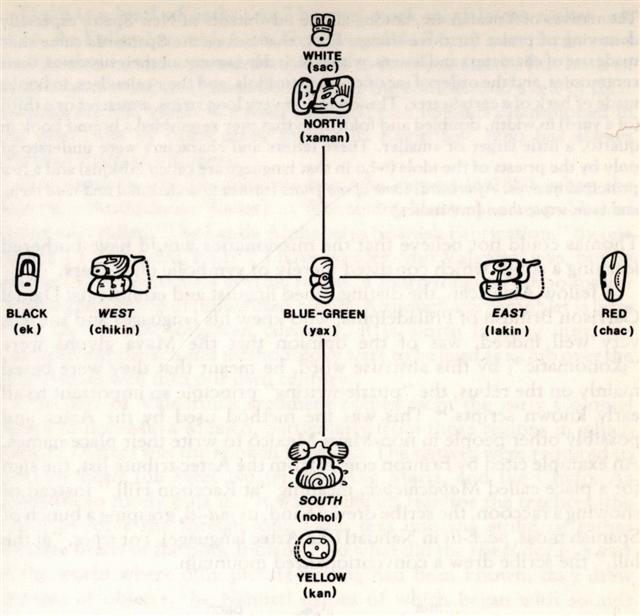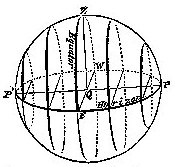We remember the 5 special stones brought from a sacred spring by the Chorti diviners:
... On February 9 the Chorti Ah K'in, 'diviners', begin the agricultural year. Both the 260-day cycle and the solar year are used in setting dates for religious and agricultural ceremonies, especially when those rituals fall at the same time in both calendars. The ceremony begins when the diviners go to a sacred spring where they choose five stones with the proper shape and color. These stones will mark the five positions of the sacred cosmogram created by the ritual. When the stones are brought back to the ceremonial house, two diviners start the ritual by placing the stones on a table in a careful pattern that reproduces the schematic of the universe. At the same time, helpers under the table replace last year's diagram with the new one. They believe that by placing the cosmic diagram under the base of God at the center of the world they demonstrate that God dominates the universe. The priests place the stones in a very particular order. First the stone that corresponds to the sun in the eastern, sunrise position of summer solstice is set down; then the stone corresponding to the western, sunset position of the same solstice. This is followed by stones representing the western, sunset position of the winter solstice, then its eastern, sunrise position. Together these four stones form a square. They sit at the four corners of the square just as we saw in the Creation story from the Classic period and in the Popol Vuh. Finally, the center stone is placed to form the ancient five-point sign modern researchers called the quincunx ... Our own cardinal directions - as also represented in the Mayan colour scheme below - has to be turned around counterclockwise with 45º in order to fit with the sequence of directions the Chorti used (NE, NW, SW, SE).
If we should read with the perspective from the time of Bharani the central glyph Gb2-8 would have corresponded to "January 1. Going back in time means turning the normal movement of time (clockwise) into its opposite (withershins). Day 45 from January 1 is February 14:
"Valentine's Day, also called Saint
Valentine's Day or the Feast of
Saint Valentine, is an annual holiday
celebrated on February 14. It originated
as a Western Christian liturgical feast
day honoring one or more early saints
named Valentinus, and is recognized as a
significant cultural and commercial
celebration in many regions around the
world ... I think the origin of this bunch of interconnected ideas was a time-line (right ascension line) through θ Piscis Austrini, from where the advancement of time could be measured.
... In the inscriptions of Dendera, published by Dümichen, the goddess Hathor is called 'lady of every joy'. For once, Dümichen adds: Literally ... 'the lady of every heart circuit'. This is not to say that the Egyptians had discovered the circulation of the blood. But the determinative sign for 'heart' often figures as the plumb bob at the end of a plumb line coming from a well-known astronomical or surveying device, the merkhet. Evidently, 'heart' is something very specific, as it were the 'center of gravity' ... See Aeg.Wb. 2, pp. 55f. for sign of the heart (ib) as expressing generally 'the middle, the center'. And this may lead in quite another direction. The Arabs preserved a name for Canopus - besides calling the star Kalb at-tai-man ('heart of the south') ... Suhail el-wezn, 'Canopus Ponderosus', the heavy-weighing Canopus, a name promptly declared meaningless by the experts, but which could well have belonged to an archaic system in which Canopus was the weight at the end of the plumb line, as befitted its important position as a heavy star at the South Pole of the 'waters below'. Here is a chain of inferences which might or might not be valid, but it is allowable to test it, and no inference at all would come from the 'lady of every joy'. The line seems to state that Hathor (= Hat Hor, 'House of Horus') 'rules' the revolution of a specific celestial body - whether or not Canopus is alluded to - or, if we can trust the translation 'every', the revolution of all celestial bodies. As concerns the identity of the ruling lady, the greater possibility speaks for Sirius, but Venus cannot be excluded; in Mexico, too, Venus is called 'heart of the earth'. The reader is invited to imagine for himself what many thousands of such pseudo-primitive or poetic interpretations must lead to: a disfigured interpretation of Egyptian intellectual life ... The alternative date July 6, which together with July 30 was used by some parts of the Eastern Orthdox Church, can easily be understood from the position of another 'heart' day, viz. Wezen (δ Canis Majoris):
... Wezen (δ at the back bone of the Great Dog) means 'weight' and we can guess the position of Rogo in Gb6-26 indicated a place to be determined by a line with a weight (Latin plumbum = lead) hanging down. ... δ, 2.2, light yellow, is the modern Wezen, from Al Wezn, Weight, 'as the star seems to rise with difficulty from the horizon'; but Ideler calls this an astonishing star name ... 2-14 at mago in Ga2-14 could allude to February 14. The design of this glyph connects it with vaha mea in Gb2-10. July 30, on the other hand, could possibly refer to nakshatra night 314, with the Good Fortune of the Swallower (Al Sa’d al Bula') close to the Full Moon. At the time of Bharani this position may have alluded to the last night of summer, because 353 ("December 19) - 80 = 273 ("September 30). By the force of the precession the stars had advanced from day 273 to day 314:
... in the ceremonial course of the coming year, the king is symbolically transposed toward the Lono pole of Hawaiian divinity ... It need only be noticed that the renewal of kingship at the climax of the Makahiki coincides with the rebirth of nature. For in the ideal ritual calendar, the kali'i battle follows the autumnal appearance of the Pleiades, by thirty-three days - thus precisely, in the late eighteenth century, 21 December, the winter solstice. The king returns to power with the sun. Whereas, over the next two days, Lono plays the part of the sacrifice. The Makahiki effigy is dismantled and hidden away in a rite watched over by the king's 'living god', Kahoali'i or 'The-Companion-of-the-King', the one who is also known as 'Death-is-Near' (Koke-na-make). Close kinsman of the king as his ceremonial double, Kahoali'i swallows the eye of the victim in ceremonies of human sacrifice ... Another heavy argument is Wilkinson's explanation of the nefer hieroglyph as a combination of heart (hanging down at bottom) and throat:
Originally this heart and throat was from a sheep. |
|||||||||||||||||||||||||||||||||||||||||||||||||||||||||||||||||||||||||||||||||||||||||||||||||||||||||||||||||||||||||||||||||||||||||||||||||||||||||||||||||||||||||||||||||||||||||||||||||||||||








